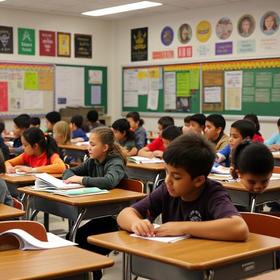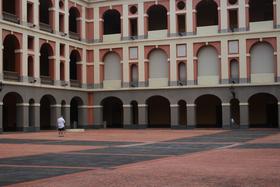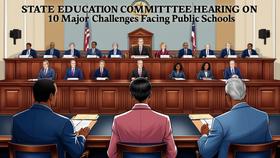Top Rankings
Jacksonville North Pulaski School District ranks among the top 20% of public school district in Arkansas for:
Category
Attribute
Diversity
Most diverse schools (Top 1%)
Community Size
Largest student body (number of students) (Top 1%)
For the 2025-26 school year, there are 5 public elementary schools serving 3,069 students in Jacksonville North Pulaski School District. This district's average elementary testing ranking is 2/10, which is in the bottom 50% of public elementary schools in Arkansas.
Public Elementary Schools in Jacksonville North Pulaski School District have an average math proficiency score of 18% (versus the Arkansas public elementary school average of 45%), and reading proficiency score of 22% (versus the 39% statewide average).
Minority enrollment is 69% of the student body (majority Black), which is more than the Arkansas public elementary school average of 43% (majority Black).
Overview
This School District
This State (AR)
# Schools
7 Schools
710 Schools
# Students
4,451 Students
300,005 Students
# Teachers
322 Teachers
19,966 Teachers
Student-Teacher Ratio
14:1
14:1
Student By Grade
District Rank
Jacksonville North Pulaski School District, which is ranked within the bottom 50% of all 257 school districts in Arkansas (based off of combined math and reading proficiency testing data) for the 2022-2023 school year.
The school district's graduation rate of 79% has decreased from 83% over five school years.
Overall District Rank
#230 out of 258 school districts
(Bottom 50%)
(Bottom 50%)
Math Test Scores (% Proficient)
16%
39%
Reading/Language Arts Test Scores (% Proficient)
22%
40%
Science Test Scores (% Proficient)
18%
36%
Graduation Rate
79%
88%
Students by Ethnicity:
Diversity Score
0.62
0.61
% American Indian
n/a
1%
% Asian
1%
2%
% Hispanic
10%
15%
% Black
53%
19%
% White
30%
57%
% Hawaiian
n/a
1%
% Two or more races
6%
5%
All Ethnic Groups
District Revenue and Spending
The revenue/student of $13,977 is higher than the state median of $13,133. The school district revenue/student has declined by 10% over four school years.
The school district's spending/student of $16,594 is higher than the state median of $13,044. The school district spending/student has declined by 10% over four school years.
Total Revenue
$62 MM
$6,371 MM
Spending
$74 MM
$6,327 MM
Revenue / Student
$13,977
$13,133
Spending / Student
$16,594
$13,044
Best Jacksonville North Pulaski School District Public Elementary Schools (2025-26)
School
(Math and Reading Proficiency)
(Math and Reading Proficiency)
Location
Quick Facts
Rank: #11.
Bayou Meto Elementary School
(Math: 30-34% | Reading: 25-29%)
Rank:
Rank:
3/
Bottom 50%10
26405 Hwy 107
Jacksonville, AR 72076
(501) 988-4131
Jacksonville, AR 72076
(501) 988-4131
Gr: PK-5 | 464 students Student-teacher ratio: 17:1 Minority enrollment: 37%
Rank: #22.
Bobby G Lester Elementary School
(Math: 28% | Reading: 31%)
Rank:
Rank:
3/
Bottom 50%10
601 Harris Rd
Jacksonville, AR 72076
(501) 982-7456
Jacksonville, AR 72076
(501) 982-7456
Gr: K-5 | 500 students Student-teacher ratio: 13:1 Minority enrollment: 66%
Rank: #33.
Murrell Taylor Elementary School
(Math: 20-24% | Reading: 15-19%)
Rank:
Rank:
2/
Bottom 50%10
1401 Murrell Taylor Dr
Jacksonville, AR 72076
(501) 985-1581
Jacksonville, AR 72076
(501) 985-1581
Gr: K-5 | 412 students Student-teacher ratio: 15:1 Minority enrollment: 80%
Rank: #44.
Jacksonville Middle School
(Math: 12% | Reading: 23%)
Rank:
Rank:
1/
Bottom 50%10
718 Harris Rd
Jacksonville, AR 72076
(501) 982-1587
Jacksonville, AR 72076
(501) 982-1587
Gr: 6-8 | 929 students Student-teacher ratio: 14:1 Minority enrollment: 73%
Rank: #55.
Jacksonville Elementary School
(Math: 15% | Reading: 14%)
Rank:
Rank:
1/
Bottom 50%10
2400 Linda Lane
Jacksonville, AR 72076
(501) 982-9541
Jacksonville, AR 72076
(501) 982-9541
Gr: K-5 | 764 students Student-teacher ratio: 17:1 Minority enrollment: 78%
Recent Articles

How Public Schools Support Students on Free / Reduced-Lunch Programs
Explore how U.S. public schools support students eligible for free or reduced-price lunch through nutrition, academic, and wraparound services in 2025.

Hidden Costs of Public Schools: Fees, Supplies & Extras
Explore the hidden costs in public schools—fees, supplies, extracurriculars—and how parents can plan for them in 2025.

Public School Funding 2025: What Families Should Know
Essential insights on public school funding in 2025—how it works, what’s changing, and what families should know to stay ahead.





